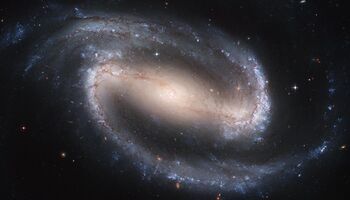Astronomy:NGC 1300
| NGC 1300 | |
|---|---|
 A Hubble Space Telescope (HST) image of NGC 1300 | |
| Observation data (J2000 epoch) | |
| Constellation | Eridanus |
| Right ascension | 03h 19m 41.1s (49.9210)[1] |
| Declination | −19° 24′ 41″ (-19.4112)[1] |
| Redshift | 0.005260 (1577 ± 4 km/s)[1] |
| Distance | 61.3 Mly (18.8 Mpc)[2] |
| Apparent magnitude (V) | 11.4[1] |
| Characteristics | |
| Type | (R')SB(s)bc[1] |
| Size | 110,000 light years in diameter |
| Apparent size (V) | 6.2′ × 4.1′[1] |
| Notable features | Huge bar-shaped core and two spiral arms |
| Other designations | |
| MCG-03-09-018,[1] ESO 547 -G 31,[1] PGC 12412,[1] UGCA 066[1] | |
NGC 1300 is a barred spiral galaxy located about 61 million light-years away in the constellation Eridanus. The galaxy is about 110,000 light-years across. It is a member of the Eridanus Cluster, a cluster of 200 galaxies.[3][4] It was discovered by John Herschel in 1835.[5]
Nucleus
In the core of the larger spiral structure of NGC 1300, the nucleus shows a "grand-design" spiral structure that is about 3,300 light-years long. Only galaxies with large-scale bars appear to have these grand-design inner disks — a spiral within a spiral. Models suggest that the gas in a bar can be funneled inwards, and then spiral into the center through the grand-design disk, where it can potentially fuel a central supermassive black hole (SMBH). NGC 1300 is not known to have an active nucleus, indicating that its central black hole is not accreting matter. The SMBH has a mass of 7.3+6.9
−3.5×107 M☉.[6][7]
At least one supernova has been observed in NGC 1300: SN 2022acko (type IIP, mag. 15.8).[8][9]
See also
- NGC 1672, a similar spiral galaxy
- NGC 7479, a galaxy with a very similar structure and both size and morphology similar
- NGC 1232, a nearby intermediate spiral galaxy
References
- ↑ 1.0 1.1 1.2 1.3 1.4 1.5 1.6 1.7 1.8 1.9 "NASA/IPAC Extragalactic Database". Results for NGC 1300. http://nedwww.ipac.caltech.edu/cgi-bin/nph-objsearch?search_type=Obj_id&objid=9121&objname=15.
- ↑ Atkinson, J.W. (2005). "Supermassive black hole mass measurements for NGC 1300 and NGC 2748 based on HST emission-line gas kinematics". Monthly Notices of the Royal Astronomical Society 359 (2): 504–520. doi:10.1111/j.1365-2966.2005.08904.x. Bibcode: 2005MNRAS.359..504A.
- ↑ "NGC 1300, a barred spiral galaxy in Eridanus". annesastronomynews.com. 2012-04-27. http://annesastronomynews.com/photo-gallery-ii/galaxies-clusters/ngc-1300/.
- ↑ "The Fornax and Eridanus Clusters". An Atlas of The Universe. http://www.atlasoftheuniverse.com/galgrps/for.html.
- ↑ Seligman, Courtney. "Celestial Atlas: NGC Objects: NGC 1300 - 1349". http://cseligman.com/text/atlas/ngc13.htm.
- ↑ Graham, Alister W. (November 2008). "Populating the Galaxy Velocity Dispersion - Supermassive Black Hole Mass Diagram: A Catalogue of (Mbh, σ) Values". Publications of the Astronomical Society of Australia 25 (4): 167–175. doi:10.1071/AS08013. Bibcode: 2008PASA...25..167G.
- ↑ Atkinson, J. W. (2005). "Supermassive black hole mass measurements for NGC 1300 and NGC 2748 based on HST emission-line gas kinematics". Monthly Notices of the Royal Astronomical Society 359 (2): 504–520. doi:10.1111/j.1365-2966.2005.08904.x. Bibcode: 2005MNRAS.359..504A.
- ↑ SN 2022acko Retrieved 29 December 2022.
- ↑ David Bishop. "Supernova 2022acko in NGC 1300". https://www.rochesterastronomy.org/sn2022/sn2022acko.html. Retrieved 2023-02-17.
External links
- HST: Barred Spiral Galaxy NGC 1300
- Hubble Heritage
- NASA Astronomy Picture of the Day: Barred Spiral Galaxy NGC 1300 (12 January 2005)
- NGC 1300 in Eridanus
 |

